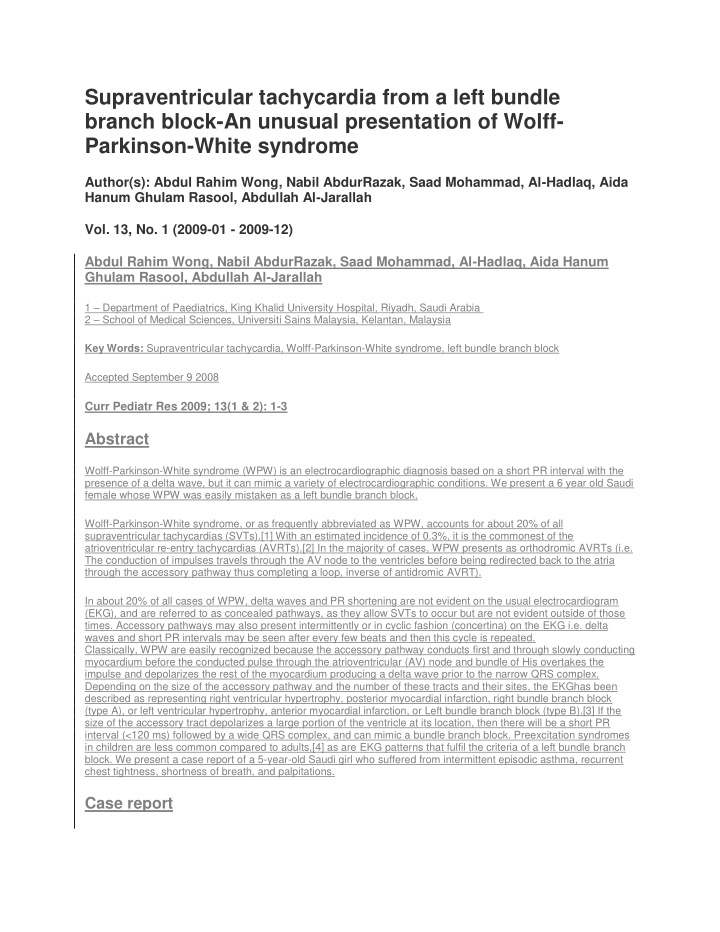



Supraventricular tachycardia from a left bundle branch block-An unusual presentation of Wolff- Parkinson-White syndrome Author(s): Abdul Rahim Wong, Nabil AbdurRazak, Saad Mohammad, Al-Hadlaq, Aida Hanum Ghulam Rasool, Abdullah Al-Jarallah Vol. 13, No. 1 (2009-01 - 2009-12) Abdul Rahim Wong, Nabil AbdurRazak, Saad Mohammad, Al-Hadlaq, Aida Hanum Ghulam Rasool, Abdullah Al-Jarallah 1 – Department of Paediatrics, King Khalid University Hospital, Riyadh, Saudi Arabia 2 – School of Medical Sciences, Universiti Sains Malaysia, Kelantan, Malaysia Key Words: Supraventricular tachycardia, Wolff-Parkinson-White syndrome, left bundle branch block Accepted September 9 2008 Curr Pediatr Res 2009; 13(1 & 2): 1-3 Abstract Wolff-Parkinson-White syndrome (WPW) is an electrocardiographic diagnosis based on a short PR interval with the presence of a delta wave, but it can mimic a variety of electrocardiographic conditions. We present a 6 year old Saudi female whose WPW was easily mistaken as a left bundle branch block. Wolff-Parkinson-White syndrome, or as frequently abbreviated as WPW, accounts for about 20% of all supraventricular tachycardias (SVTs).[1] With an estimated incidence of 0.3%, it is the commonest of the atrioventricular re-entry tachycardias (AVRTs).[2] In the majority of cases, WPW presents as orthodromic AVRTs (i.e. The conduction of impulses travels through the AV node to the ventricles before being redirected back to the atria through the accessory pathway thus completing a loop, inverse of antidromic AVRT). In about 20% of all cases of WPW, delta waves and PR shortening are not evident on the usual electrocardiogram (EKG), and are referred to as concealed pathways, as they allow SVTs to occur but are not evident outside of those times. Accessory pathways may also present intermittently or in cyclic fashion (concertina) on the EKG i.e. delta waves and short PR intervals may be seen after every few beats and then this cycle is repeated. Classically, WPW are easily recognized because the accessory pathway conducts first and through slowly conducting myocardium before the conducted pulse through the atrioventricular (AV) node and bundle of His overtakes the impulse and depolarizes the rest of the myocardium producing a delta wave prior to the narrow QRS complex. Depending on the size of the accessory pathway and the number of these tracts and their sites, the EKGhas been described as representing right ventricular hypertrophy, posterior myocardial infarction, right bundle branch block (type A), or left ventricular hypertrophy, anterior myocardial infarction, or Left bundle branch block (type B).[3] If the size of the accessory tract depolarizes a large portion of the ventricle at its location, then there will be a short PR interval (<120 ms) followed by a wide QRS complex, and can mimic a bundle branch block. Preexcitation syndromes in children are less common compared to adults,[4] as are EKG patterns that fulfil the criteria of a left bundle branch block. We present a case report of a 5-year-old Saudi girl who suffered from intermittent episodic asthma, recurrent chest tightness, shortness of breath, and palpitations. Case report
A 5-year-old Saudi girl who suffers from intermittent episodic asthma was first admitted 6 months previously with an acute exacerbation of her asthma and received 2.5mg of nebulised salbutamol. She developed SVT that was observed on the cardiac monitor in the emergency room. This was aborted via vagal manoeuvres, and an EKG (Fig. 1) was obtained the next day. She was discharged “well”, and provided with salbutamol and budesonide metered dose inhalers. Larger image here Figure 1a. Electrocardiogram demonstrating a left bundle branch block in a 5 year old girl. Larger image here Figure 1b. Delta wave and LBBB are highlighted from figure 1a by circles, fulfilling part of the criteria for Wolff- Parkinson-White syndrome Larger image here
Figure 2a. Supraventricular tachycardia in the same patient. Six months later, she suffered another episode of chest tightness associated with wheezing. She was again given nebulized salbutamol and developed SVT with a heart rate of about 250 bpm. This time vagal maneuvers were unsuccessful and adenosine was employed in increasing doses starting at 100mcg/kg till 300mcg/kg/dose was reached in 5 attempts that were unsuccessful, this was not captured during the emergency. IV amiodarone infusion was then started and an EKG (Fig. 2) was obtained after half an hour of admission to our pediatric intensive care unit. Larger image here Figure 2b. The figure is the same as figure 2a, but with the circles illustrating the inverted p waves seen after the QRS complexes in leads II and III. The arrow points to the appearance of P wave after the QRS complex in aVF. Larger image here Figure 3. Electrocardiogram obtained 11 days after amiodarone conversion from the same patient showing disappearance of the LBBB Figure 3 was obtained 7 days after being discharged on oral amiodarone, and she is currently awaiting electrophysiology testing and radiofrequency ablation at a neighboring centre as we do not have the facility nor expertise at our centre. Discussion Features of Wolff-Parkinson-White syndrome that can and had been mistaken for bundle branch blocks, and was overlooked as the possible cause for this child’s supraventricular tachycardia is shown in Figure.1a and b. The cardinal features are short PR interval, presence of delta waves and a wideQRS complex that resembled a left BBB (see Figure 1b). Figure 2a and b also demonstrate a feature more typical of orthodromic atrioventricular
Recommend
More recommend